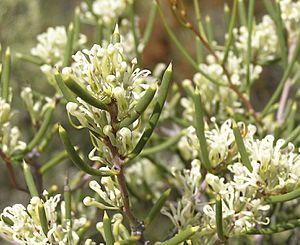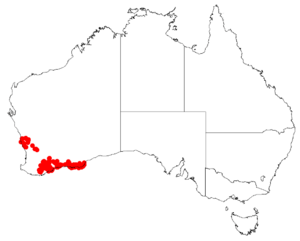Needles and corks facts for kids
Quick facts for kids Needles and corks |
|
|---|---|
 |
|
| Hakea obliqua growing near Lake Monginup | |
| Scientific classification | |
| Genus: |
Hakea
|
| Species: |
obliqua
|
 |
|
| Occurrence data from AVH | |
Hakea obliqua, often called needles and corks, is a unique shrub. It belongs to a plant family called Proteaceae. This plant is special because it grows only in certain parts of Western Australia. You can find it in regions like the Wheatbelt, Great Southern, and Goldfields-Esperance.
Contents
What Does it Look Like?
Hakea obliqua is a tall, bushy shrub. It usually grows to be about 0.5 to 3 meters (1.6 to 9.8 feet) high. Its young branches and new growth often have a rusty color.
Leaves and Flowers
The leaves of this plant are like stiff needles. They are thick and can be 1 to 7 centimeters (0.4 to 2.8 inches) long. Each leaf ends in a sharp, upright point.
The flowers are strongly scented and grow in small groups. There are usually 2 to 8 flowers in each cluster. They are white, cream, or yellow, sometimes with a hint of green. These clusters appear where the leaves meet the stem.
Fruit and Life Cycle
The fruit of the Hakea obliqua is large and round. It measures about 2 to 4.5 centimeters (0.8 to 1.8 inches) long and wide. When the fruit is young, it feels smooth. But as it gets older, its surface becomes covered in thick, bumpy cork-like growths.
The fruit tapers to a point at the top. This point can be either curved or straight, and it's about 1 to 6 millimeters (0.04 to 0.24 inches) long. The plant usually flowers between May and October.
How it Got its Name
This plant was first officially described in 1810. A famous botanist named Robert Brown gave it its scientific name. He published his description in a scientific paper.
The second part of its name, obliqua, comes from a Latin word. Obliquus means "oblique" or "slanted." This name refers to a part of the flower called the nectar gland, which is set at a slant.
Where Does it Grow?
Hakea obliqua is found in southern Western Australia. Its habitat stretches from the Stirling Range all the way to Albany and even to Israelite Bay. You can also find it further inland near Pingrup.
This plant prefers to grow in areas with heath and scrubland. It thrives in sandy soil or soil that is a mix of sand and loam.
Is it Protected?
The Western Australian Government has looked at the status of Hakea obliqua. They have classified it as "not threatened." This means the plant is not currently at risk of disappearing.

